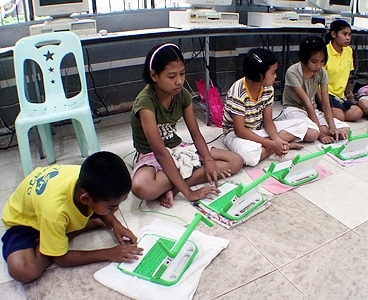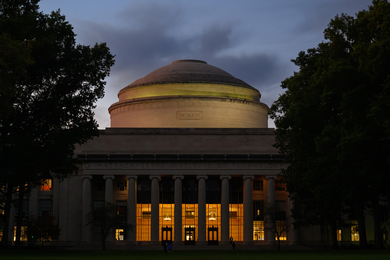What difference does technology make for the world’s poor? This question prompted sharply worded exchanges at a recent MIT public forum as researchers offered markedly differing views about the effectiveness of technological fixes for poverty.
“The solution to poverty is education, and the way you get learning is in my mind very much connected to technology,” said Nicholas Negroponte at the Dec. 2 event. Negroponte is the co-founder of MIT’s Media Lab, and founder of the nonprofit group One Laptop per Child, which has distributed roughly 2 million laptop computers to children, mostly in South America, Africa and the Caribbean. “Technology has fundamentally changed things” in places with inadequate schooling, Negroponte asserted, citing examples of children who taught their parents to read using computers.
Others were more circumspect about the impact of technology. Studies in India have shown that schools can better target the skill level of students either with or without computers, said Rachel Glennerster, executive director of MIT’s Abdul Latif Jameel Poverty Action Lab (J-PAL), which specializes in randomized trials evaluating the effectiveness of anti-poverty programs.
“The need is making learning more adaptive,” said Glennerster. “You can use technology to do that, or you can use another method to do that.”
The panel’s first speaker, Kentaro Toyama, a researcher in the School of Information at the University of California, Berkeley, set out a firmly skeptical position. “Technology ultimately doesn’t deliver on its extreme promise, which is that it’s going to fundamentally change the way that we deal with our complex social problems,” he said. “Computers in schools help students if the schools are already good, but that technology tends to hurt schools that are not functioning well,” added Toyama, who studied how the world’s poor use technology for Microsoft Research India from 2005 to 2009.
What can countries afford?
Glennerster, Negroponte and Toyama were among five speakers at the Dec. 2 event in Wong Auditorium, “Can Technology Solve Global Poverty?” a part of the ongoing series of “Ideas Matter” forums presented jointly by MIT’s Department of Political Science and the Boston Review.
The skepticism of technology on display was anathema to Negroponte, who called various remarks offered by his fellow panelists “wrong,” “ridiculous,” and “nonsense.” Where many anti-poverty programs featuring technology have floundered in the developing world, said Negroponte, “that hasn’t been because of the technology, it’s because they were done badly.”
At issue is not just the effectiveness of technology, but also its cost. One Laptop per Child provides computers at a cost of about $1 per child per week. J-PAL studies have shown that deworming children — giving them medicine to rid them of intestinal worms — increases school attendance and educational achievement at a cost of about 50 cents per child per year, or about 1 percent of the expense of a laptop.
That means programs must be both effective and inexpensive, argued Glennerster, noting that GDP per capita in Sierra Leone, one country where she does research, is about $300 per year, and health expenditures per person in some developing countries are about $6 per year. To find out if technology is “the best and cheapest way” to tackle poverty, she stated, “We just have to test it. We can’t sit here and say obviously [technology] is the answer. We’ve got to compare the costs of doing things in different ways.”
One Laptop and J-PAL
Glennerster also said that J-PAL researchers had offered to evaluate One Laptop per Child but had been rebuffed. “We have a center for doing very rigorous scientific studies, and we have a number of people who have tried to do randomized control trials [of One Laptop per Child] and we’re just told, ‘No, you don’t get it, you’re just going to [study] test scores, you don’t get it, it’s transformative.’”
Asked by an audience member if he would let J-PAL evaluate One Laptop per Child, Negroponte noted that institutions such as the World Bank and the Inter-American Development Bank have already positively assessed the program. “OLPC has participated in an enormous amount of evaluation,” said Negroponte, who is currently on leave from MIT. The program, he said, “still costs a little too much,” but is effective.
Jose Gomez-Marquez, program director of MIT Innovations in International Health initiative, noted that applying technology means more than just personal computing. “Information is an aspect of technology. But in reality technology is also about tools, about ways of creating devices,” said Gomez-Marquez, who has helped create vaporizers that deliver vaccines for the poor.
And Gomez-Marquez urged patience in evaluating the impact of technology in poor countries. “When you’re on the ground, it’s very frustrating when somebody doesn’t answer their e-mail for two weeks, given that they’ve been given a brand-new laptop,” Gomez-Marquez noted. That comes with the territory, he added: “It’s a developing world. It’s not Lexington.”
“The solution to poverty is education, and the way you get learning is in my mind very much connected to technology,” said Nicholas Negroponte at the Dec. 2 event. Negroponte is the co-founder of MIT’s Media Lab, and founder of the nonprofit group One Laptop per Child, which has distributed roughly 2 million laptop computers to children, mostly in South America, Africa and the Caribbean. “Technology has fundamentally changed things” in places with inadequate schooling, Negroponte asserted, citing examples of children who taught their parents to read using computers.
Others were more circumspect about the impact of technology. Studies in India have shown that schools can better target the skill level of students either with or without computers, said Rachel Glennerster, executive director of MIT’s Abdul Latif Jameel Poverty Action Lab (J-PAL), which specializes in randomized trials evaluating the effectiveness of anti-poverty programs.
“The need is making learning more adaptive,” said Glennerster. “You can use technology to do that, or you can use another method to do that.”
The panel’s first speaker, Kentaro Toyama, a researcher in the School of Information at the University of California, Berkeley, set out a firmly skeptical position. “Technology ultimately doesn’t deliver on its extreme promise, which is that it’s going to fundamentally change the way that we deal with our complex social problems,” he said. “Computers in schools help students if the schools are already good, but that technology tends to hurt schools that are not functioning well,” added Toyama, who studied how the world’s poor use technology for Microsoft Research India from 2005 to 2009.
What can countries afford?
Glennerster, Negroponte and Toyama were among five speakers at the Dec. 2 event in Wong Auditorium, “Can Technology Solve Global Poverty?” a part of the ongoing series of “Ideas Matter” forums presented jointly by MIT’s Department of Political Science and the Boston Review.
The skepticism of technology on display was anathema to Negroponte, who called various remarks offered by his fellow panelists “wrong,” “ridiculous,” and “nonsense.” Where many anti-poverty programs featuring technology have floundered in the developing world, said Negroponte, “that hasn’t been because of the technology, it’s because they were done badly.”
At issue is not just the effectiveness of technology, but also its cost. One Laptop per Child provides computers at a cost of about $1 per child per week. J-PAL studies have shown that deworming children — giving them medicine to rid them of intestinal worms — increases school attendance and educational achievement at a cost of about 50 cents per child per year, or about 1 percent of the expense of a laptop.
That means programs must be both effective and inexpensive, argued Glennerster, noting that GDP per capita in Sierra Leone, one country where she does research, is about $300 per year, and health expenditures per person in some developing countries are about $6 per year. To find out if technology is “the best and cheapest way” to tackle poverty, she stated, “We just have to test it. We can’t sit here and say obviously [technology] is the answer. We’ve got to compare the costs of doing things in different ways.”
One Laptop and J-PAL
Glennerster also said that J-PAL researchers had offered to evaluate One Laptop per Child but had been rebuffed. “We have a center for doing very rigorous scientific studies, and we have a number of people who have tried to do randomized control trials [of One Laptop per Child] and we’re just told, ‘No, you don’t get it, you’re just going to [study] test scores, you don’t get it, it’s transformative.’”
Asked by an audience member if he would let J-PAL evaluate One Laptop per Child, Negroponte noted that institutions such as the World Bank and the Inter-American Development Bank have already positively assessed the program. “OLPC has participated in an enormous amount of evaluation,” said Negroponte, who is currently on leave from MIT. The program, he said, “still costs a little too much,” but is effective.
Jose Gomez-Marquez, program director of MIT Innovations in International Health initiative, noted that applying technology means more than just personal computing. “Information is an aspect of technology. But in reality technology is also about tools, about ways of creating devices,” said Gomez-Marquez, who has helped create vaporizers that deliver vaccines for the poor.
And Gomez-Marquez urged patience in evaluating the impact of technology in poor countries. “When you’re on the ground, it’s very frustrating when somebody doesn’t answer their e-mail for two weeks, given that they’ve been given a brand-new laptop,” Gomez-Marquez noted. That comes with the territory, he added: “It’s a developing world. It’s not Lexington.”






